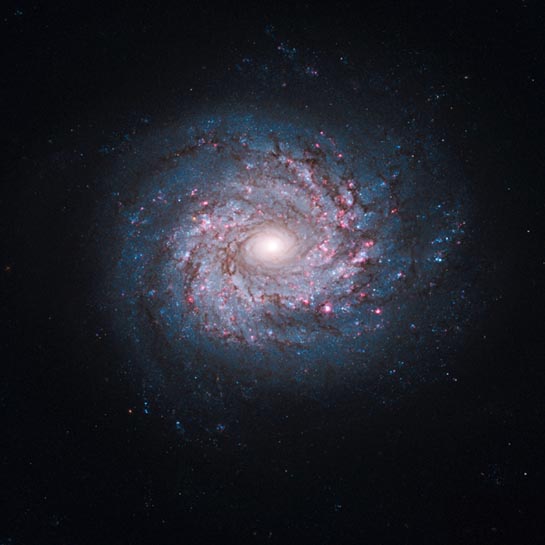
Face-on Spiral Galaxy
RA 11h 56m 28s.13 Dec +55° 07' 30".86
Ursa Major
68 million light-years (26 million parsecs)
11.0
2.3 x 2 arcmin
March 2000 - August 2009
Multiple proposals totaling 25.5 hours
NASA, ESA, and the Hubble Heritage Team (STScI/AURA)
October 19, 2010
2003 image: G0311
ABOUT THIS IMAGE:
Though the universe is chock full of spiral-shaped galaxies, no two look exactly the same. This face-on spiral galaxy, called NGC 3982, is striking for its rich tapestry of star birth, along with its winding arms. The arms are lined with pink star-forming regions of glowing hydrogen, newborn blue star clusters, and obscuring dust lanes that provide the raw material for future generations of stars. The bright nucleus is home to an older population of stars, which grow ever more densely packed toward the center.
NGC 3982 is located about 68 million light-years away in the constellation Ursa Major. The galaxy spans about 30,000 light-years, one-third of the size of our Milky Way galaxy. This color image is composed of exposures taken by the Hubble Space Telescope's Wide Field Planetary Camera 2 (WFPC2), the Advanced Camera for Surveys (ACS), and the Wide Field Camera 3 (WFC3). The observations were taken between March 2000 and August 2009. The rich color range comes from the fact that the galaxy was photographed in visible and near-infrared light. Also used was a filter that isolates hydrogen emission that emanates from bright star-forming regions dotting the spiral arms.
The image is a composite of separate exposures made by the WFPC2, ACS, and WFC3 instruments on the Hubble Space Telescope. Three filters were used to sample broad and narrow wavelength ranges. The color results from assigning different hues (colors) to each monochromatic image. In this case, the assigned colors are: F555W (V) blue-cyan, F658N (H-alpha+[N II]) red and F814W (I) red-yellow
From Wikipedia:
NGC 3982 is an intermediate spiral galaxy approximately 68 million light-years away in the constellation Ursa Major. It is also known as UGC 6918. It was discovered by William Herschel on April 14, 1789 and misclassified as a planetary nebula. NGC 3982 is a part of the M109 Group.
At an apparent magnitude of 12.0, NGC 3982 needs a telescope to be viewed. Using small telescopes, the galaxy appears as a very faint, diffuse patch of light with its central region appearing as a slightly brighter diffuse ball.
NGC 3982 is a Seyfert 2 galaxy that spans about 30,000 light-years, about one-third of the size of our Milky Way galaxy. The galaxy is receding from us at about 1109 km/s. The galaxy is a typical spiral galaxy, similar to our Milky Way. It harbors a supermassive black hole at its core and has massive regions of star formation in the bright blue knots in the spiral arms. Supernovae are likely to be found within these regions.
NGC 3982 has a high rate of star birth within its arms, which are lined by pink star-forming regions of glowing hydrogen and newborn blue star clusters. Its bright nucleus is home to older populations of stars, which grow more densely packed toward the center. The galaxy also has active star formation in the circumnuclear region estimated at 0.52 solar masses/year. The HST image of NGC 3982 shows a mini-spiral between the circumnuclear star-forming region and the galaxy's nucleus, which could be the channel through which gas is transported to the supermassive black hole from the star-forming region.
NGC 3982 is a member of the M109 Group, a group of galaxies located in the constellation Ursa Major that may contain over 50 galaxies. The group was named after the brightest galaxy in the group, the spiral galaxy M109.
Astronomers are interested in studying this galaxy as it can help in measuring extragalactic distances. It is helpful because it possesses two tools used to estimate astronomical distances: supernovae and Cepheid variable stars